12 to 20 September 2022
The passage from Gibraltar to Lanzarote Marina is 630 nautical miles. If we manage to travel at five nautical miles an hour, we should arrive in 4 to 5 days. Little do we know that this sail down the vast Atlantic Pond would take us longer than the expected five days, and in the end, it would take us eight due to…well, you’ll read all about it soon.
Day 1
We set sail from our anchorage in La Linea, Spain, next to Gibraltar at 06:30 sharp. We want to catch the Gibraltar Strait tides by 08:30 to push us towards the Atlantic and not, hopefully, back into the Mediterranean. Once we have light, there is a flurry of dolphins catching what seems to be birds flying low on the water…I am disgusted, as I have never heard of dolphins behaving this way. On closer inspection, it turns out that the dolphins are chasing up flying fish and having a salty breakfast.
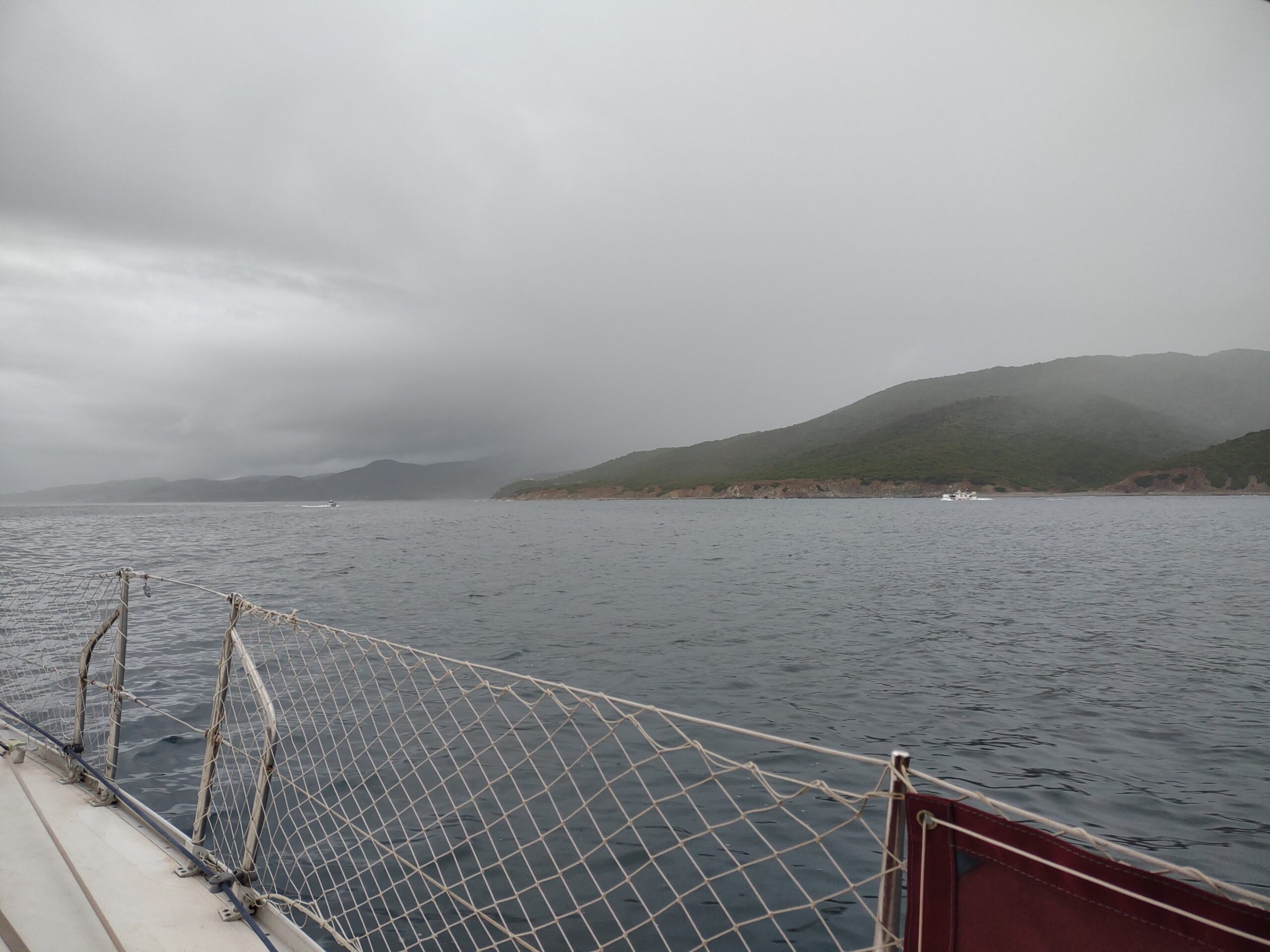
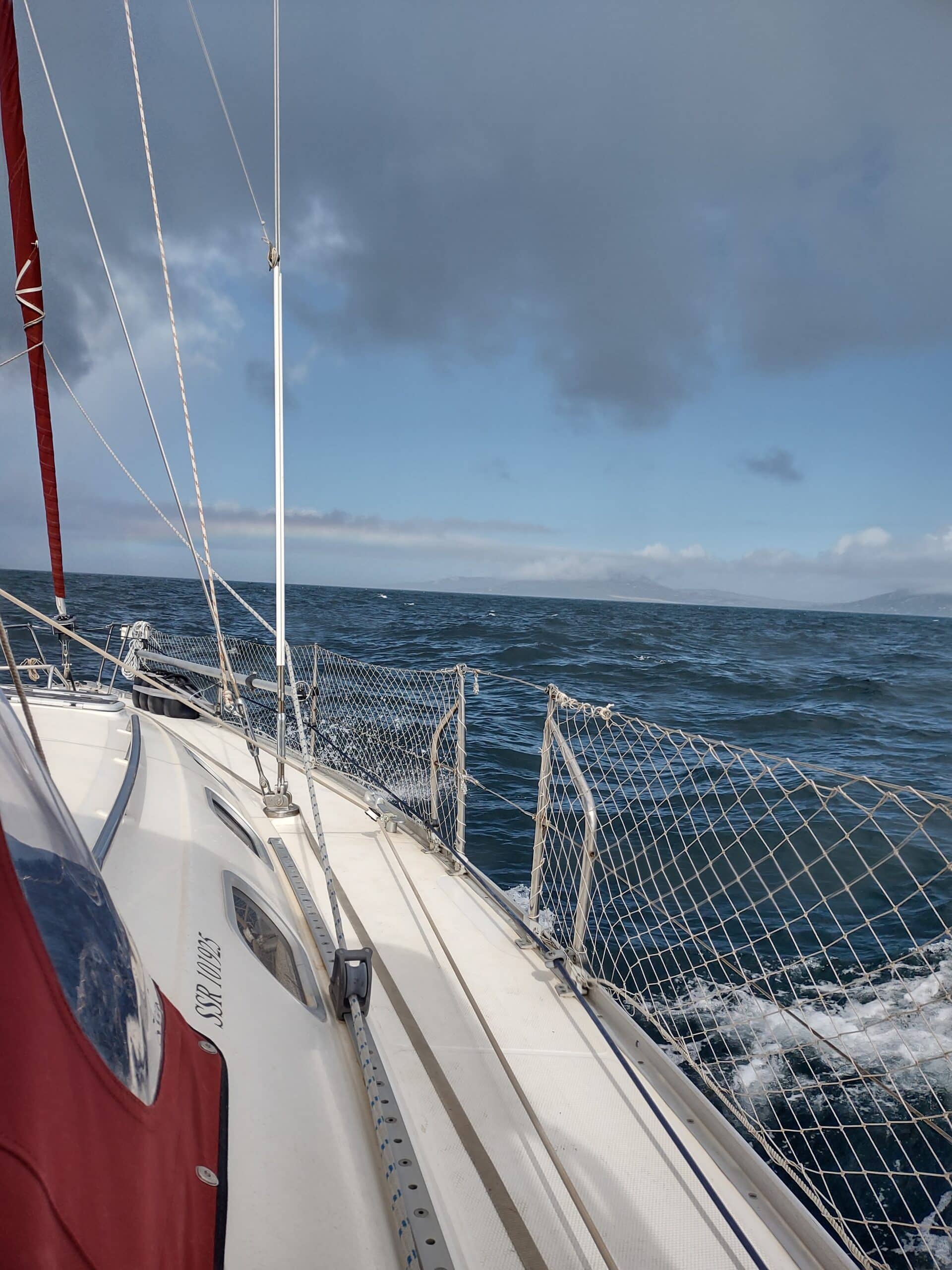
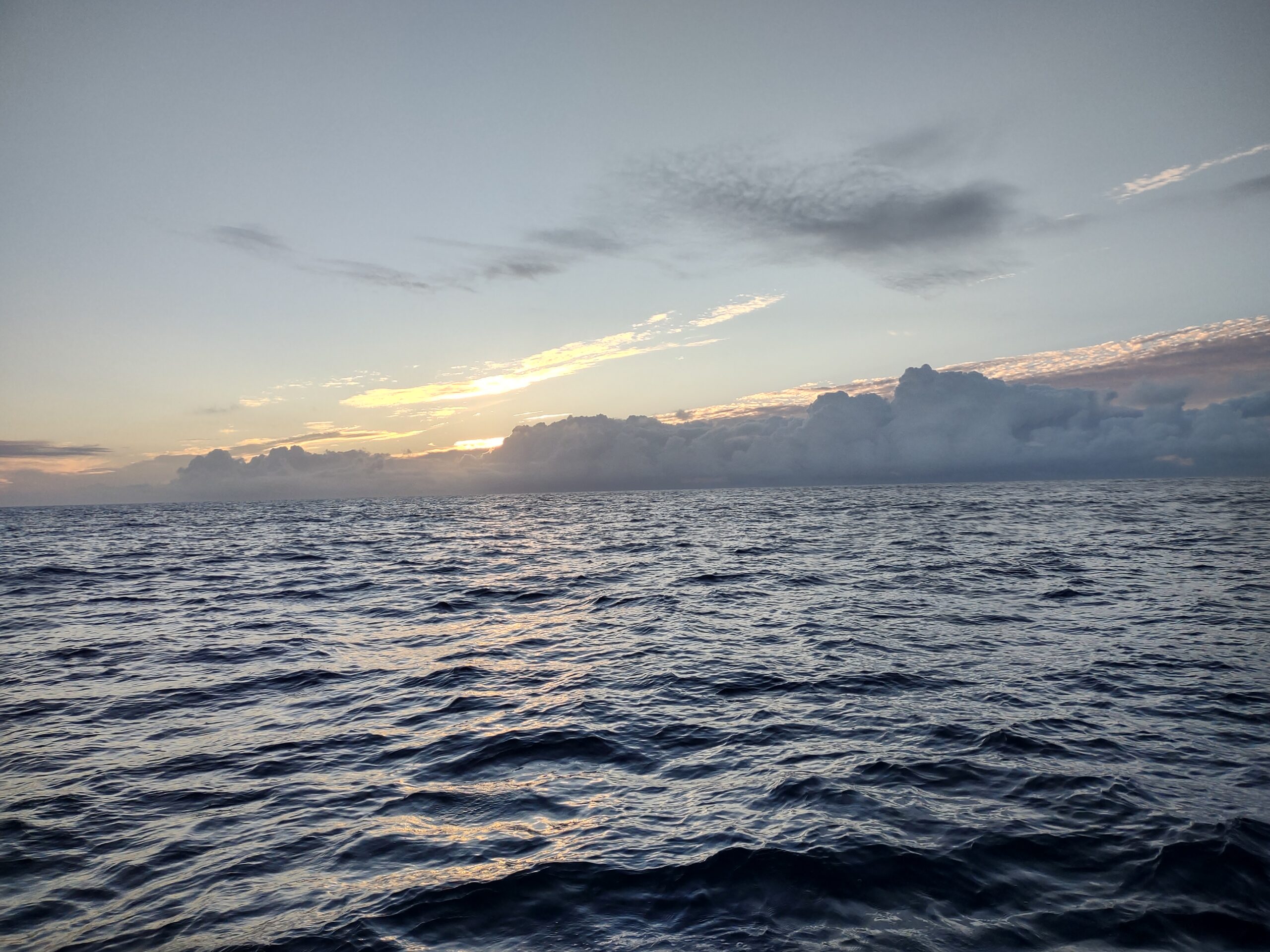
We planned correctly, and pass Tarifa just before the tide turned would force us back to Gibraltar. By late afternoon we start to cross the shipping lanes off of the Moroccan coast. We have read to watch out for the fishing nets around this area. They are not always marked, and the fishermen set these nets as far as 30 nautical miles offshore. The markers to look out for at night, would be a flashing of red and green lights.
By dusk, a small fishing boat speed toward us. Black smoke fumes from this dinky-looking fishing boat and its crew up in arms with buoys and flashlights trying to stop us. We are cautious as we have heard accounts of piracy and would prefer not to start this leg of our journey as hostages in Morocco. We ignore them and attempt to sail faster…finally, they give up, and we lose sight of them. Phew, have we just ducked pirates? But all will be revealed in due course.
The tides off the African coast are constantly against us, and we struggle to make progress on sail. We have a sheet marking how many engine hours we do to ensure we do not run out of fuel. Friends of ours had the misfortune of running on fumes as they entered Lanzarote in the Canary Islands, as there was no wind during their passage. We have guesstimated that Susie Jane runs about 4 litres of fuel per hour when traveling at 5 knots (and no wind). We would only be able to motor for 82 hours, which would only get us two-thirds of the way. So, we take every opportunity to sail, even if we move at 2 knots an hour. Once the sun has set, we see the tell tail signs of fishing nets, green and red flashing lights on the surface of the water. There is a fair amount behind us, and only a couple showing up on the horizon. We will keep a keen eye on them, as no sailor wants the misfortune of getting tangled in tons of fishing gear.
With Ava and Will safely tucked into their beds (pillows to the sides to avoid them crashing into the sides of their cabins), Sander and I start our new routine of 2.5-hour shifts. In the past, we have not been strict about how and when we sleep and usually took hour power naps, but this crossing would be a couple of days, and we need to entertain the children during the day, so a schedule is a necessity to avoid bad tempers and tired sailors.
Day 2
By 2:30 am, we are all comfortable, all our sails up and engine off. As Sander and I change our shifts, we hear a tremendous knock, and our rudder turns 270 degrees to port. What has just happened? We are away from the orca zone…and then it hits us; we are now the ‘catch of the day’ for some unsuspecting fishermen.
How could this have happened? We have both been watching the flashing lights, and chose a route through some flashing lights that was about 2 miles long, but this part of the net was clearly not working. Due to the tide and wind, Susie Jane is pinned onto the net. The main fishing line runs under the hull and forces itself against the rudder and keel. Our only hope to reduce the force is to take down our sails and lose all stability. Without our sails, Susie Jane becomes an auditorium of crashing and clanging from outside and in. Waves are banging at her hull, and the sound of pots and glasses displaced makes for a chaotic experience. We cannot switch the engine on, or our propeller would get tangled in the net and we’d be in an even bigger situation. Ironically, our insurer said they would insure us for the crossing to the Caribbean if this crossing went without fail. Sander attempts to push the net down from the sugar scoop (swimming platform on our stern (back of the boat)) with our boat hook, but the waves crashing over him, and the weight of the net make this impossible.
We can now see that we are piggy-in-the-middle of a fishing net running about 4 miles around. We use our flashlights to try and signal for help from a fishing boat, but they do not come. Finally, I suggest to Sander that we cut the net. Luckily, Sander has the foresight not to (later, we learn that the fishermen are known to hunt down boats that have destroyed their nets and sadly, their livelihood). After two hours of struggling and being jostled about, a fisher boat comes closer. We are relieved and still anxious about piracy. I make a feeble attempt to look more masculine, but the squeaky voice shouting over to them for help is a dead giveaway.
Remember those fishermen (potential pirates)… they were not pirates but humble fishermen warning us that they were setting nets all around us and wanted us to change our course to avoid being trapped. The fishing boat comes up close enough to see the fishermen’s faces and disgruntled expressions. We attempt to communicate with them in English, Portuguese and Spanish, but they only respond in Arabic, and we come to understand that communication will commence in flashing flashlights for direction and the occasional ‘no no’ or ‘good’ ‘good’. They toss over a rope, and sign for us to attach the line to the bow. Once we are tied on, they put their engine on full power and yank Susie Jane, but she will not move. It was a big tug, and I am not sure Susie Jane would withstand this manhandling. Then a second attempt, and this time we are free. But to avoid being pushed back onto the net by the wind and tied, we put the engine to full speed and head back to where we came from; Gibraltar and the shipping lanes.
The fishermen signal which direction we need to head for, and occasionally they would motor close to us to send us further away from the unmarked fishing net. We now understand that we are trapped and would have never been able to navigate our way out from this net. Two fishing boats have set up their nets in a perfect circle around us. It takes us another 3 hours and numerous flashlight signalling, and channel 16 calls “no capitan, no capitan,” or “yes capitan, yes capitan,” thus signalling that we are turning in the wrong or correct direction to get out of this colossal fishing zone and right back to the shipping lane we passed 10 hours ago.
Please note that the VHF is not meant to be used this way. You need official training and an exam to use the VHF correctly in the United Kingdom. It would seem that using the VHF in the manner that these fishermen are, is the only way they can communicate with vessels and warn them of the fishing nets they have strung around.
By this point, the children have been bounced and pushed about their cabins, and seasickness dawns upon us again. But all things considered, we are safe, have not noticed any damage, and heading to the Canaries. We are still able to pick up the calls on the VHF from the fishermen to the gigantic cargo ships steaming through their nets, “no mister, please mister, turn mister,” and when you hear “naughty mister, naughty Capitan,” it is clear that the ship has not changed course and has rummaged through their catch and nets.
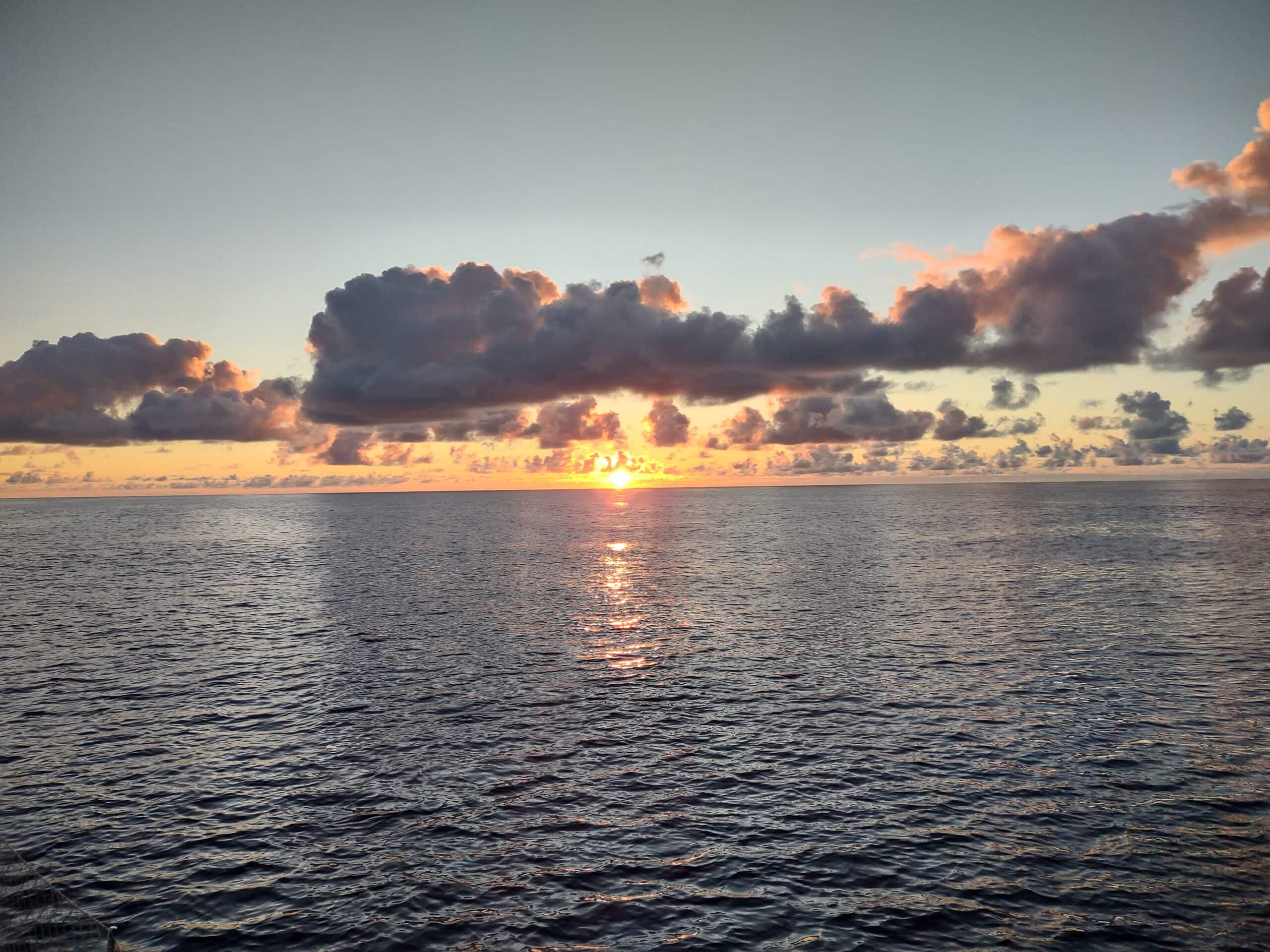
It has also dawned upon us that this sail will take longer than expected, as the whole fishing line ordeal has brought us a day off of the preferred weather window. We will have no more wind at our current position and further down to the Canary Islands.
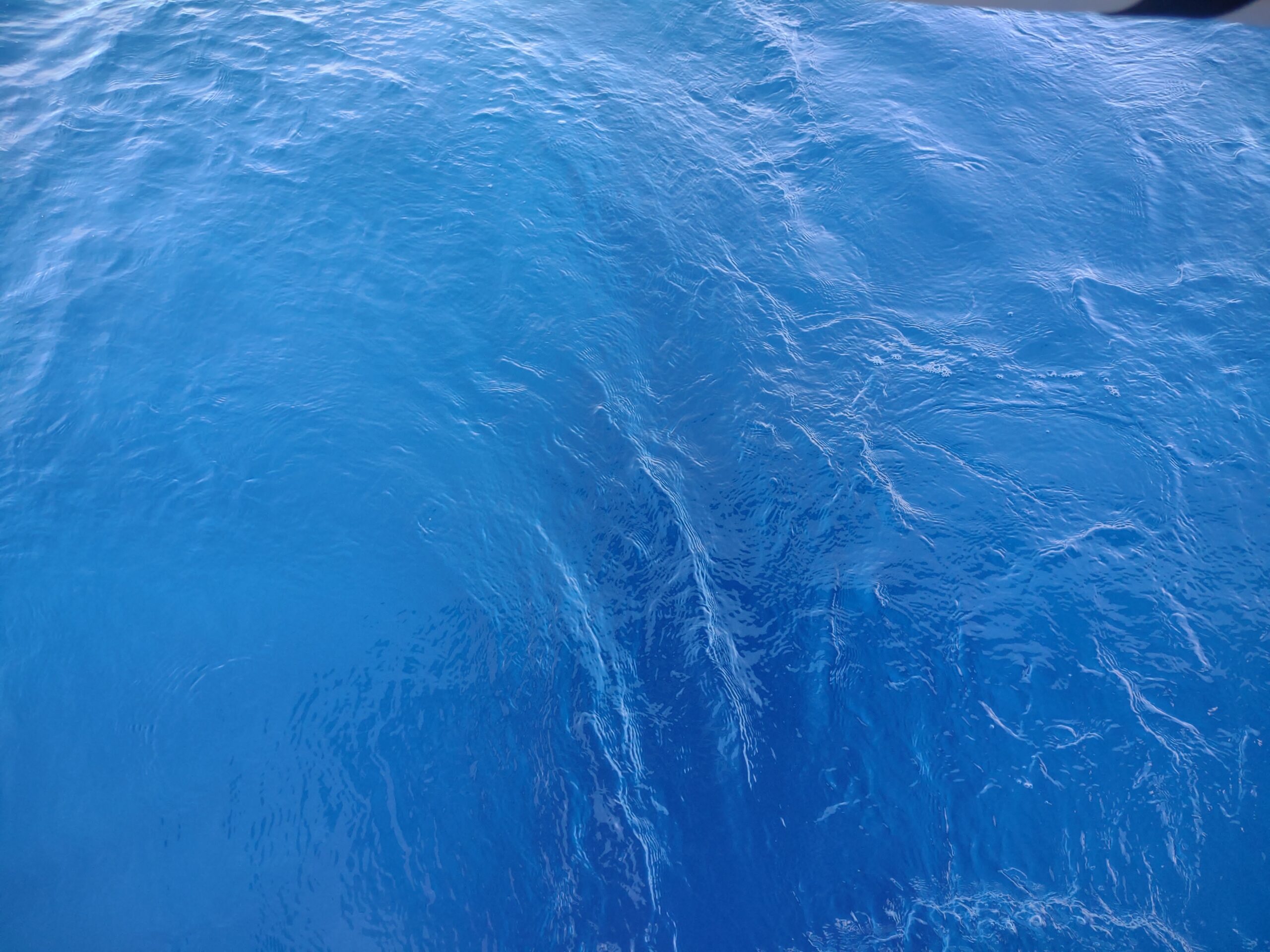
We use our SSB radio to send short emails and download weather files called Grib files. We manage to download a file that confirms we have no more wind for the next two days. So, we sail at 2 knots and sometimes have an occasional becalming moment of no movement. We spot a pod of pilot whales slowly moving through the water. Moments like these remind us how lucky we are to be this close to nature.
To save on water, we hand-wash our clothes in fresh water, rinse (very carefully) from the stern in the seawater, and then another freshwater rinse. This technique seems to work well, as the clothes are pulled and pushed by the movement of the ocean allowing for a proper washing machine experience. By nightfall, the skies are lit by millions of lights, and the ocean seems to reflect them, along with dots of bioluminescence, making for a spectacular evening sail. By midnight, a giant orange moon lights up our boat and brings some wind.
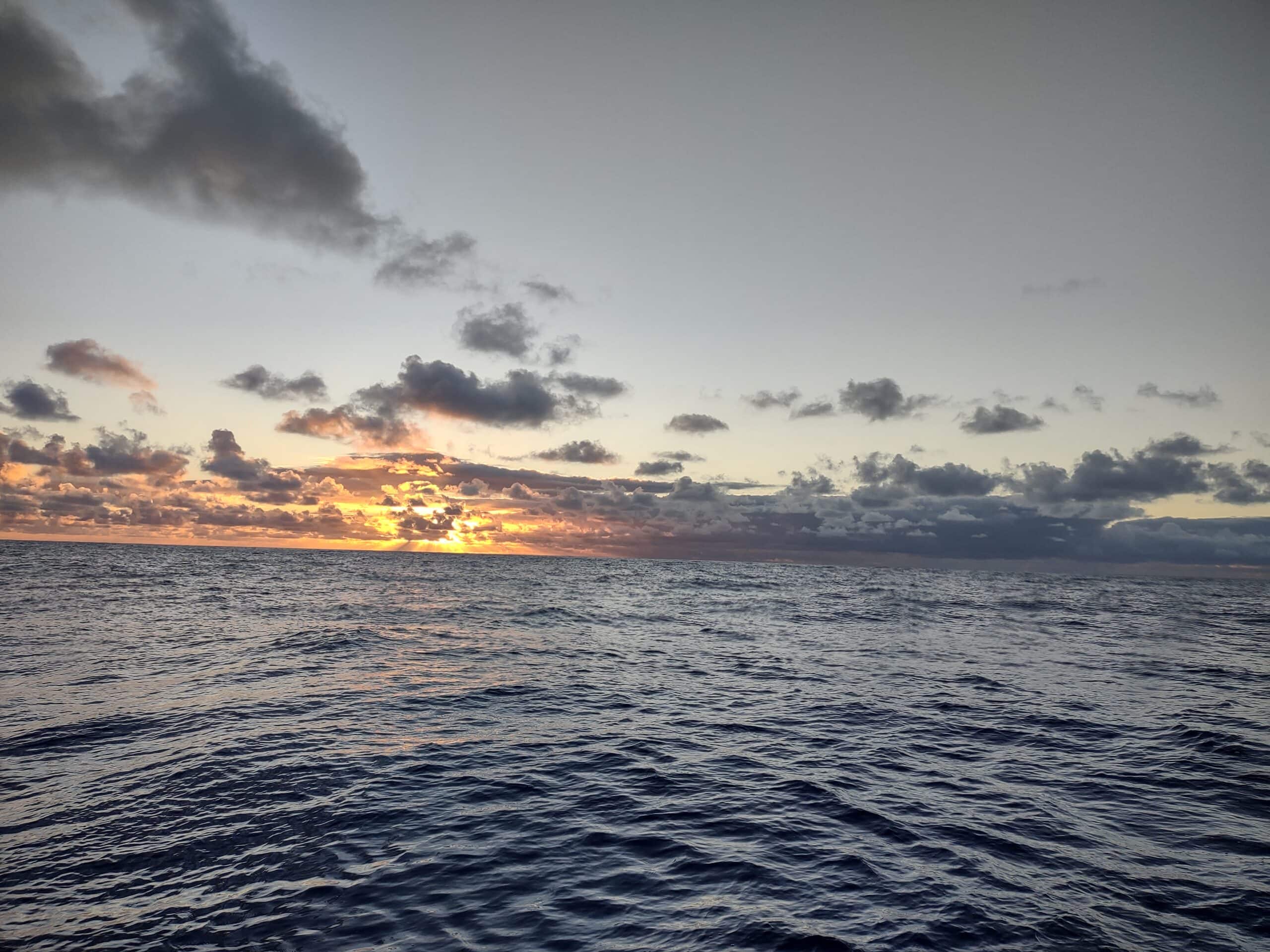
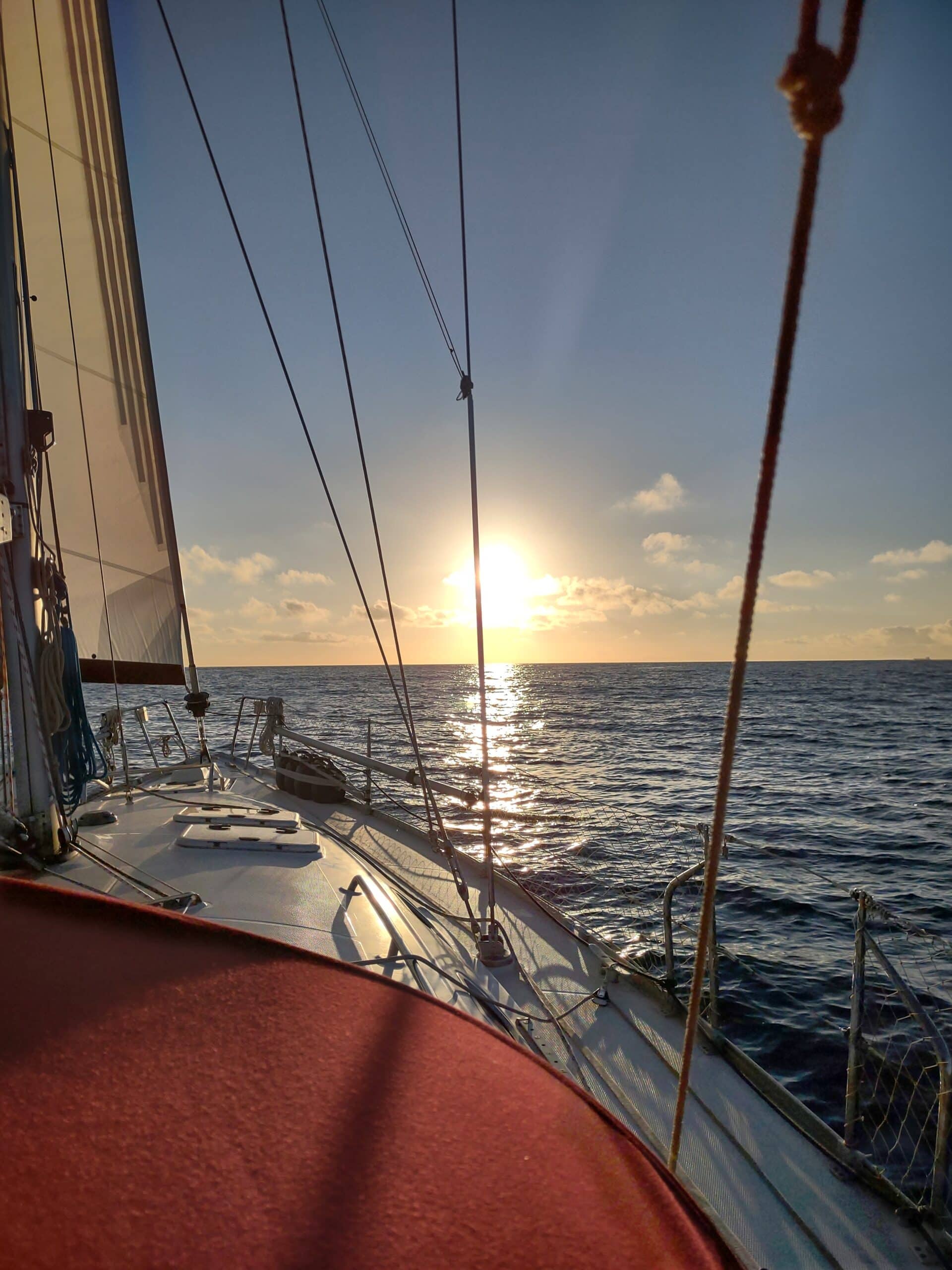
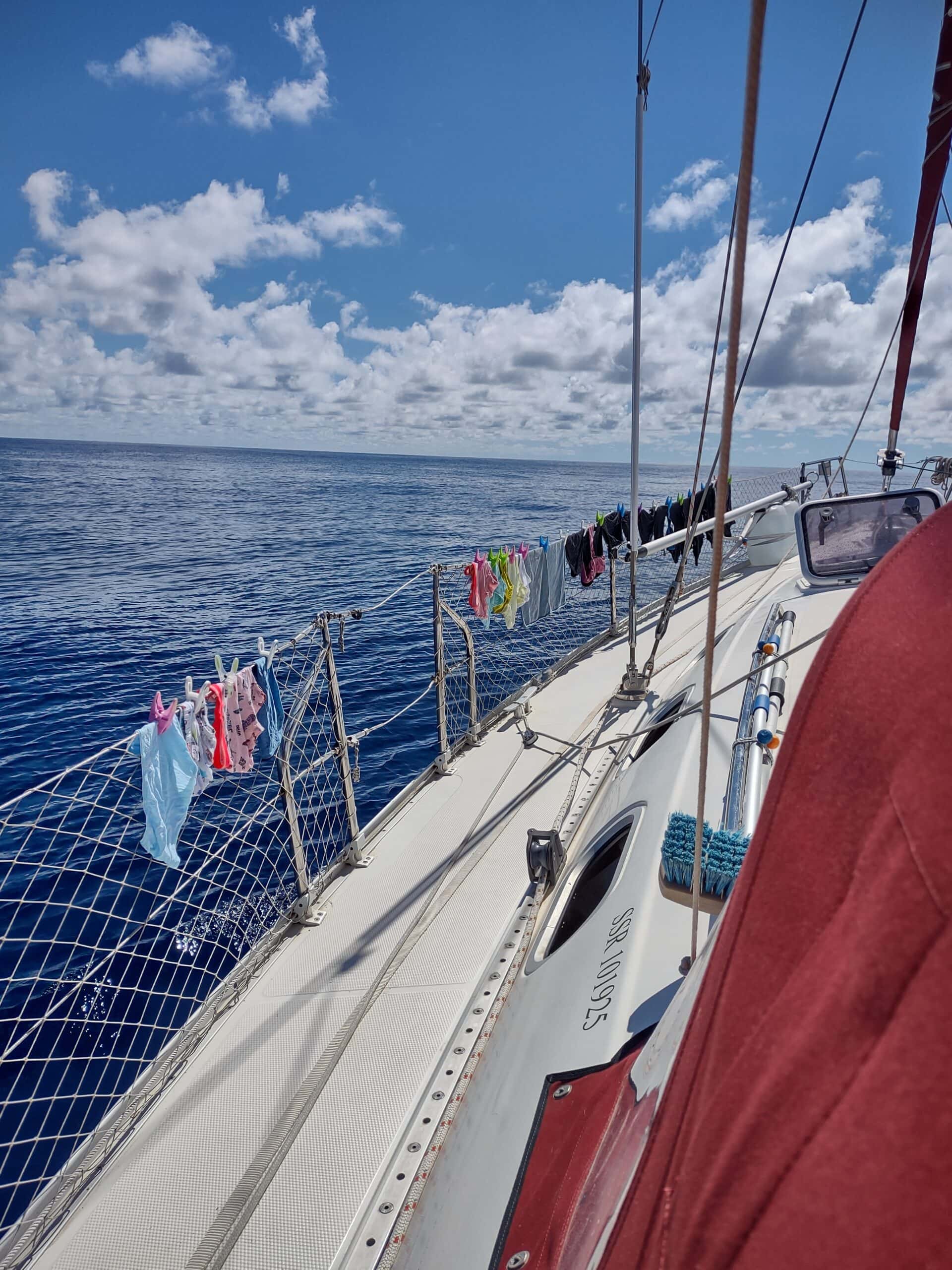
Day 3
The wind persists to 07:00; then we move back to a snail’s pace of 2 knots. The swell is beam-on (hitting us directly on the side of our hull, causing an uncomfortable ride for a couple of hours). But this, too, dies down like the wind. During the evening, the boat is filled with a fishy smell. We are not sure whether this was just the general smell of the ocean or our imaginations playing tricks.

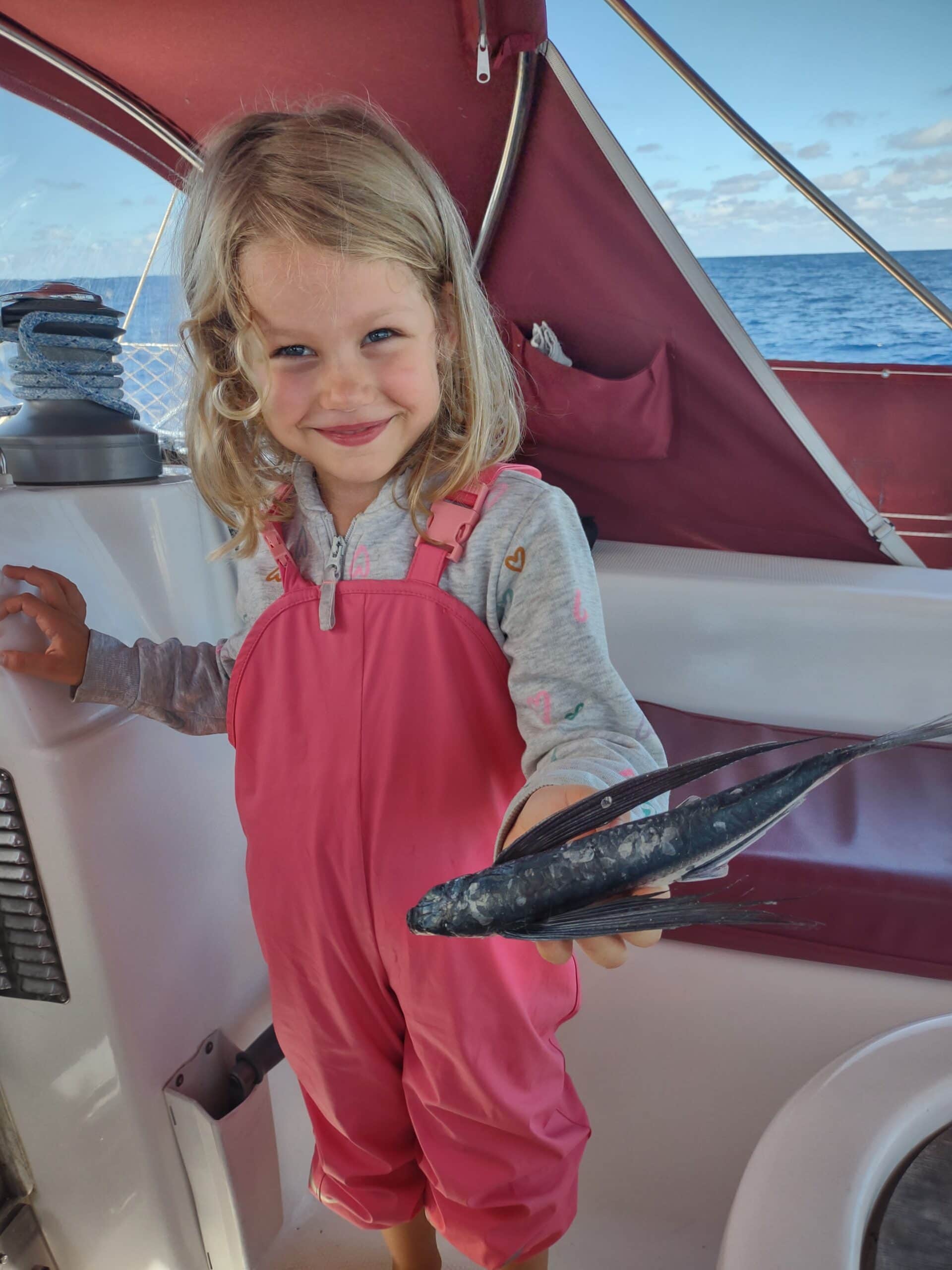
Day 4
In the morning, we discover a giant flying fish (actually, it might be small, we do not know). Sadly he had landed on our boat during the evening (thus the smell) and was not able to get back into the water. The flying fish reminds us of entertaining video documentation we watched a year ago of a couple circumnavigating in the 50s. This couple would collect the flying fish that had died on their boat the night before and then cook them up for breakfast.
Sander has been trying his hand at fishing, and today he is convinced an enormous tuna (or a large shiny piece of imagination…only jokes) left his line broken…it was a big fish, so we might need to invest in more robust equipment.
We have attempted everything from poling out to sailing with only our headsail to reduce the impact of the waves on the movement of the sails. Having a sail bang is a massive annoyance for any sailor and creates unwanted wear. When the wind dies down, we switch on the engine at low revolutions (still saving fuel) to keep on our course and reduce the bobbing about in the swell.
To our greatest excitement (things are really boring in these conditions), we notice another sailboat on our exact course heading straight for us. The irony of having two boats on the same approach is bizarre in the ocean’s vastness. They are in the same boat as us and have also been struggling to find wind. They are heading to Rabat in Morocco, and after a few minutes of VHF communication, they tell us that they have been sailing for 34 years.. and have still to complete their planned circumnavigation from Canada. Could this be us too in a couple of decades?
We have been relying on the autopilot for the last couple of days to steer the boat. It’s time for Rob, our Hydrovane, to make an appearance. A hydrovane is a self-steering mechanism. As it is purely mechanical, we do not use any electricity to power it, and the mechanism steers without sound, making for a peaceful sail. When you have set your sails, you can adjust the vane of the Hydrovane to steer your vessel. If there is a marginal change in wind direction, the Hydrovane will adapt the course and ensure you stay on the wind for as long as possible. In addition, the Hydrovane acts as a second rudder if you have lost steerage on your primary rudder.
And if you wonder what evening/early morning watches consist of—games on your phone (Sander plays the Paperclip game, and I play some random maths games). Then there is the exciting moment of making coffee or spotting a satellite. Your mind wanders, and you think of all the people you have left behind. How are they? What are they doing? You miss smiles and the laughs and the hugs. We miss you all and look forward to seeing you again on the other side.

Day 5
Today should have been our arrival day in Lanzarote, but we still have 300 nautical miles to go. We are averaging 2.8 knots an hour, and at this pace, we have made peace with the new slow-paced sail. We have noticed many tiny fruit flies about the boat and realized that the breeding spot is our composting toilet.
We installed the toilet as we do not have a black water-holding tank onboard. It worked a charm until it became a hostel for hundreds of tiny fruit flies. The ventilation hose has a fly filter, so the culprit here was a lid left open. The cover must be closed when the toilet is not in use to ensure the closed system can ventilate through the ventilation hose. Clearly, the Gibraltarian fruit flies did not hesitate when the opportunity arose to board a free trip to the Canary Islands. An hour later, all hostel occupants had been evacuated, but we found many stowaways hiding in the freshwater drains.
As night falls, we have a constant 6-9 knot breeze blowing Susie Jane forward. We have noticed that the night brings more wind (12 knots), but this is not the case this evening. And we continue to bob about at 2 – 3 knots.
We speak jokingly of our food reserves and how many interesting baked bean dishes we could come up with; baked bean poke bowl, baked beans on toast, or a baked bean bake (life has become exceptionally simple).
Day 6
Early morning rotation puts me on duty at 02:30-05:00. Two cargo ships have appeared on the horizon, and both will cross our track a couple of minutes apart. I get anxious and hope they have seen our tiny blip on this encompassing landscape of black water. These are scary and exciting moments at the same time. We will hit one ship if I go to starboard; if I swerve to port, we will be on a collision path with the second. I am determined not to disturb Sander from his much-needed sleep, and I stay on our course and clench every muscle in my body. One of the ships deviates and allows for a spectacular view of colossal ships passing us on both sides.
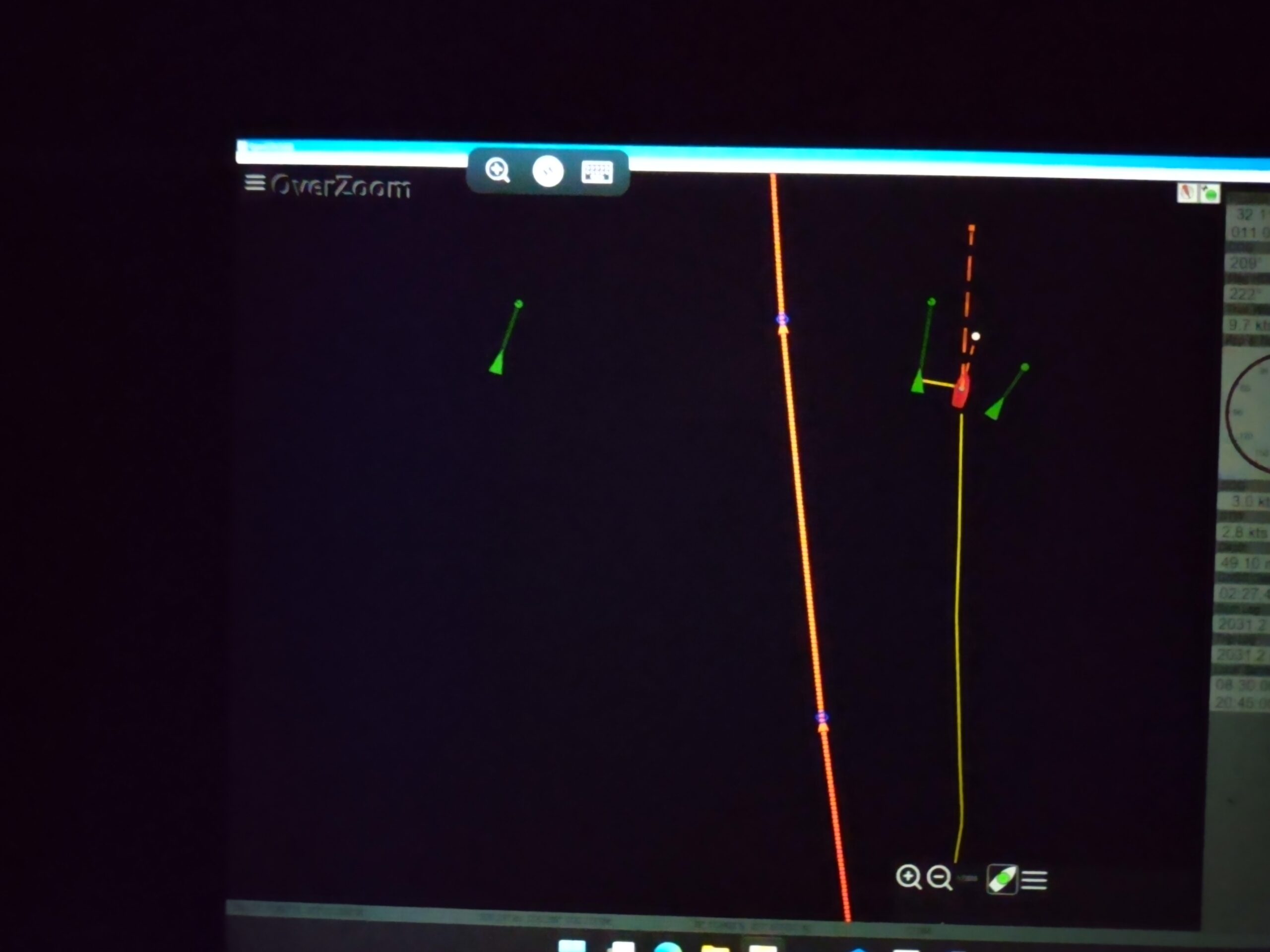

By early morning, we are greeted by a pod of dolphins playing on the bow waves as we inch closer to our destination. By 19:00, we have only covered 65 nm in 24 hours. Due to cloud coverage and limited minutes to transmit from our SSB, we have been unable to send a message to my mum or Sander’s parents for the last two days. We can only hope they have not called the coast guard.
Day 7
Early morning watches are beautiful. Starry night sky reflected in the water. By 03:22, the orange moon starts to rise. The moon has begun to rise later and later, and this is the latest by far. Funny how you start to miss certain routine happenings in your monotonous day. It’s a sight to behold. The moon rises out of the blanket of twinkles, and its reflection looks like a strobe light lighting up our past track.
We have another 130 nautical miles to go and no wind. We have enough fuel for this but must travel at a snail’s pace. We bake a cake to add excitement to the usual rhythm of sailing without wind. And as the cake is decorated and ready to be had, we are joined by a bird we name Peter Canary Pan.
We had a few birds land on our boat for a short rest, but PCP was different. He nested on the children’s heads and perched on their fingers from time to time. He was also much smaller than the usual ones that had landed on our boat. We were getting attached and wondered how Nova would handle what should be her food as a traveling companion. Sadly, by late afternoon, Peter Canary Pan had died. Later (once we had internet), we read that he was a European Pied Flycatcher. He was not eating our food because he is an insect eater. They migrate from their breeding grounds in Europe to tropical Africa. Ava is the most devastated, and Peter Canary Pan has an official burial at sea.
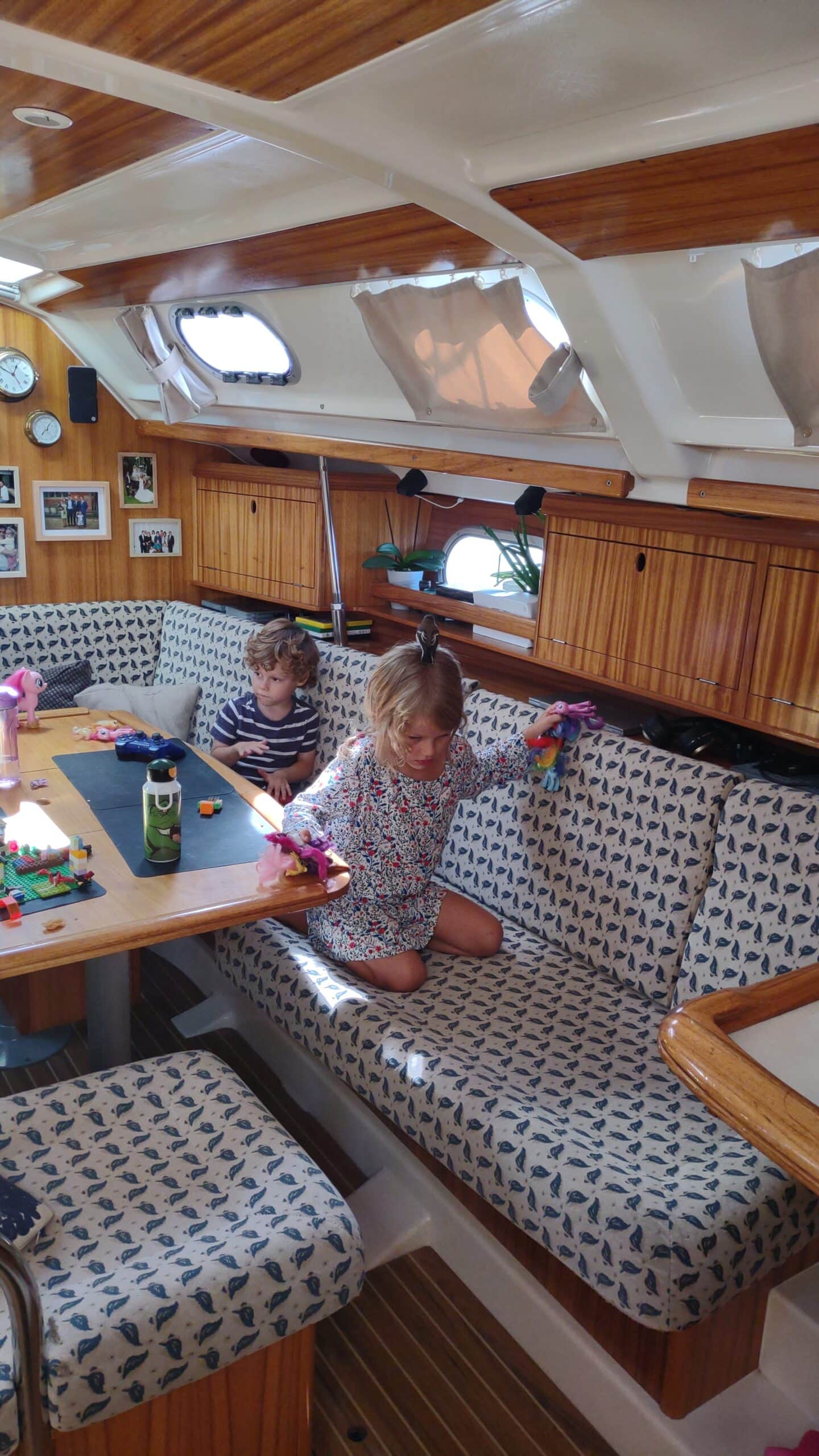
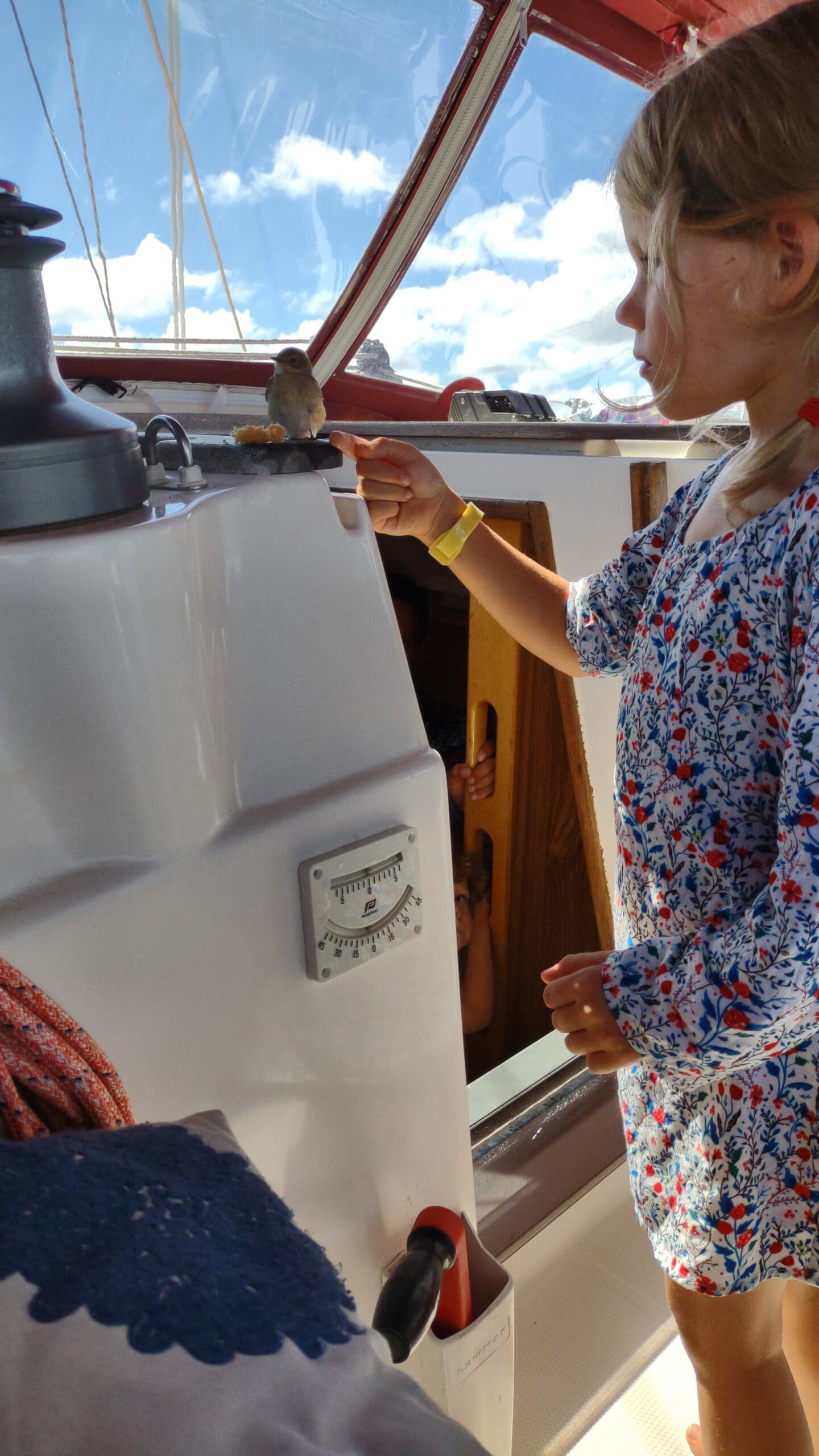
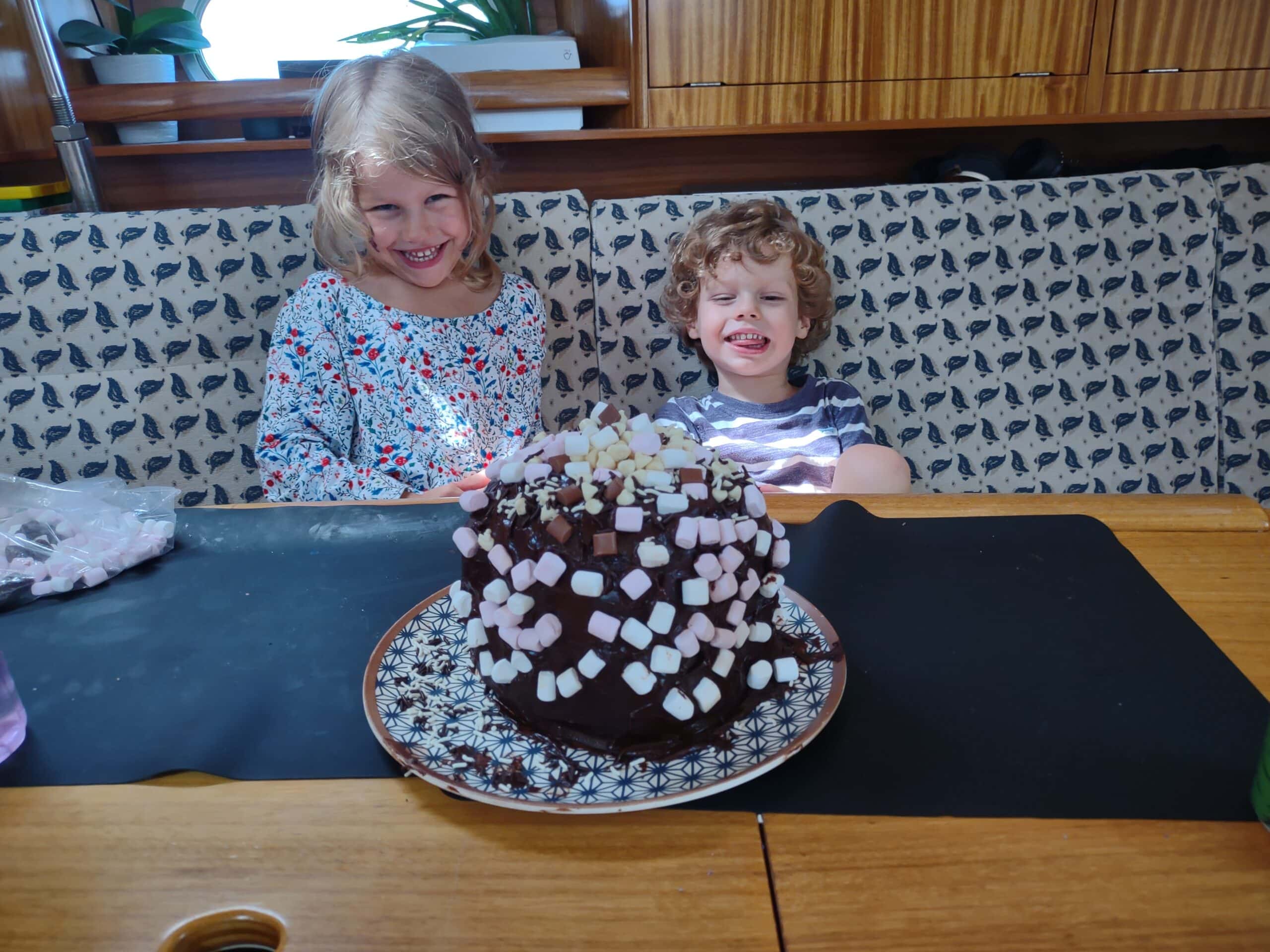
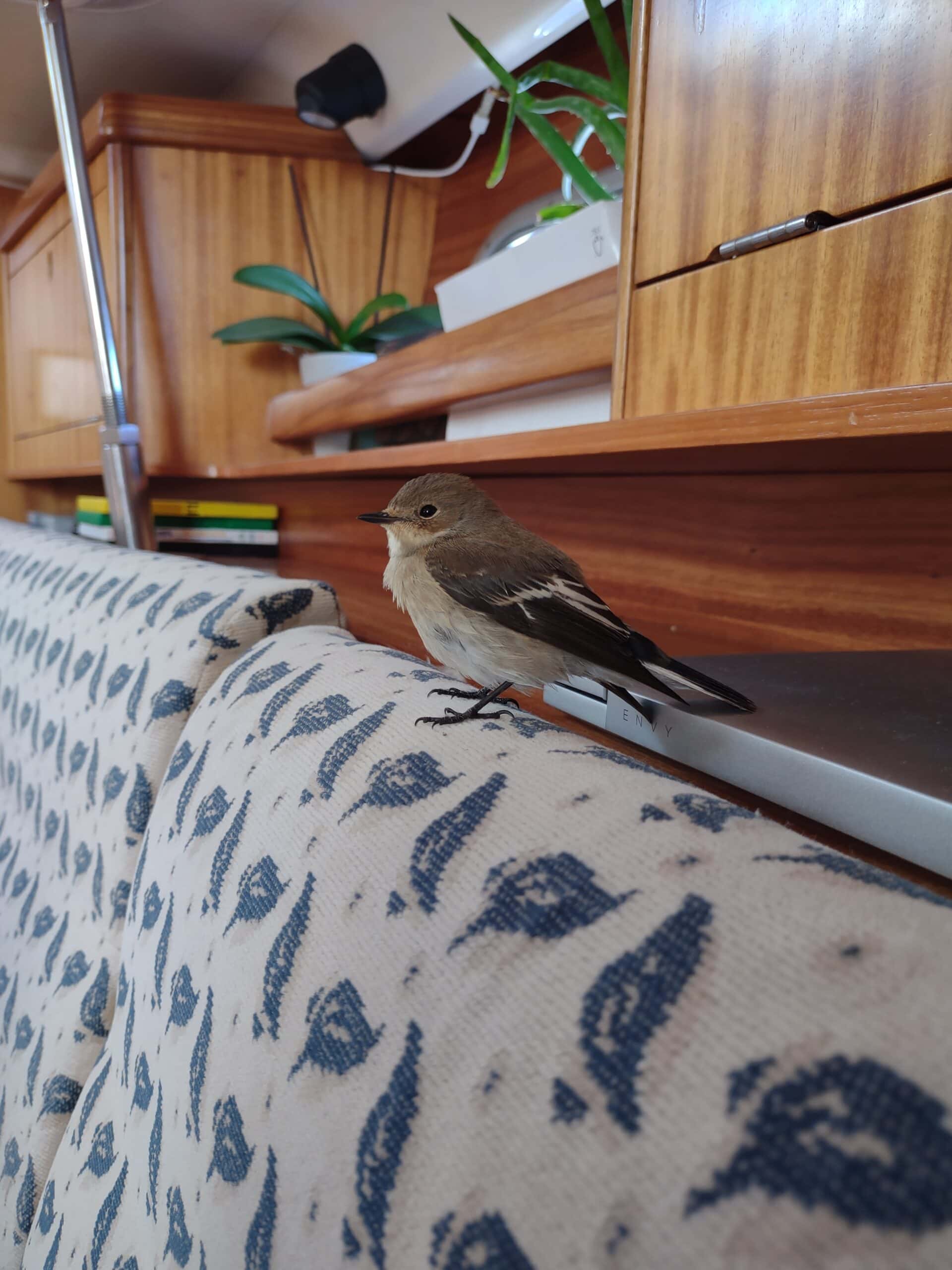
Day 8
Another day passes with little to no wind. As we reach a shallow, the waves pick up, and Sander reads that it is due to a depression in the Sahara, which should last till late afternoon. The waves make Susie Jane twist and jerk. The sails are not enjoying this, and we struggle to balance her out. By now, Sander is tired, and we decide to put the engine on and head for land. We only have 60nm to go and are surprised to see that our strict use of the engine has left us with two thirds of a tank of fuel. We are met by a large pod of 20 spotted dolphins. Is this the beginning of the end? Have they come to say goodbye and wish us well on land. Later that afternoon, we are entertained by another smaller pod of common dolphins. One seems to have escaped from a zoo as he jumps up into the sky, belly flops, or does entire twirls mid-air.

We now only have 45 nm to go, and the edges of the land start to appear. On our VHF, we hear reports of 4 different boats with migrants around the islands. Migrants from the north and northwest of Africa risk their lives (sometimes sailing in makeshift wooden boats without engines) to make landfall and apply for asylum on the Spanish Islands. We are now on full alert and discuss what we would do if we came across a boat with children—a moral dilemma. The Spanish coast guard asks that you call in a Pan Pan on VHF channel 16 if you have spotted a migrant vessel and maintain a safe distance but stay close to the boat until rescue services can reach them.
We have stopped using our main sail for the last two days as the vang seems damaged. When we hit the fishing net, we suspect the unnatural force on the vang caused a crack and some minor hairline cracks. To reduce wear, we stop using our mainsail (which usually helps to balance the boat out on rocky waters). The rudder installation has also come loose in the process, and Sander manages to fix this in no time.
By 04:00, we are close to Lanzarote port and are now fighting the strong swell against the boat and high winds. Sander needs to hand steer as the autopilot is not strong enough to resist the pressure on the rudder. Once we enter the port, things calm down, and by the first shimmer of light, we tie down our last mooring line.
We have arrived, and suddenly you forget about the endless days of no wind and drifting. The peace and frustration that comes along with this, has become relief and pride. We have learned many lessons along the way (as we usually do), and we do not take the sea for granted. She is powerful, and you are always at her mercy. To celebrate a safe passage, which is now part of our tradition, we crack open a Saint Emilion gifted to us by my brother and enjoy the sound of people and the smell of land.
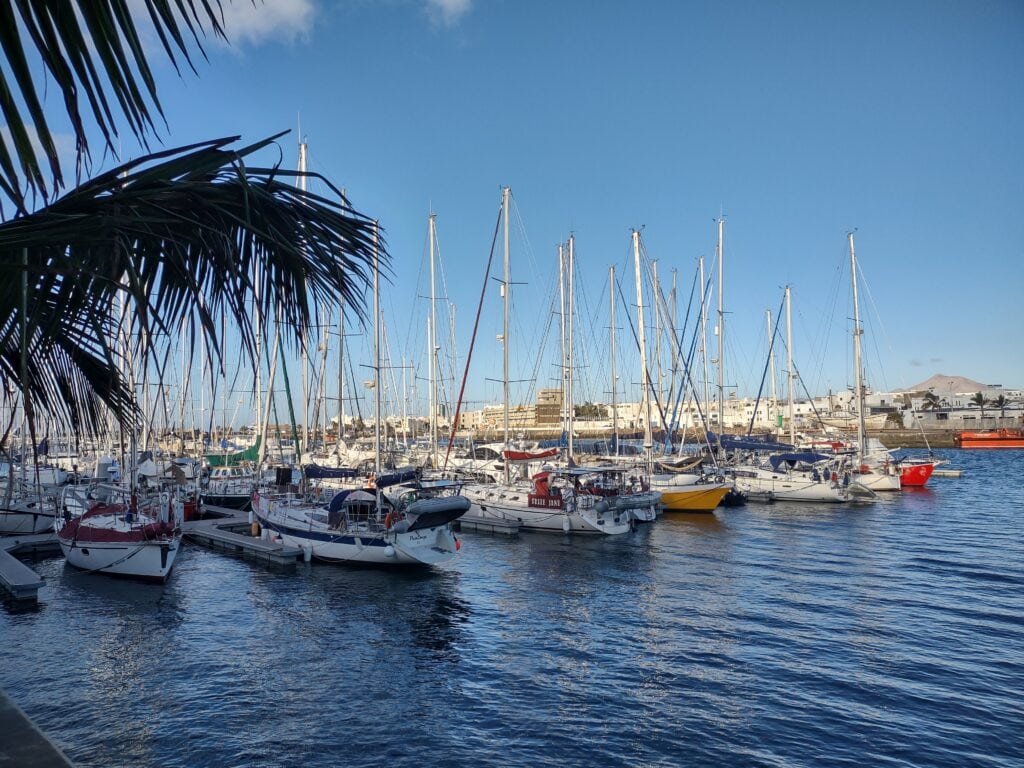
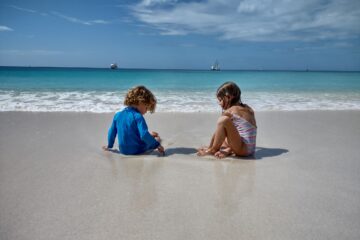
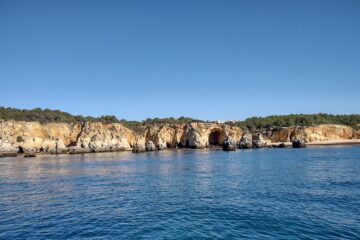
2 Comments
Eric · November 7, 2022 at 2:08 pm
Great narrative and nice photographs again Danielle!! . Keep up the blogs coming!!
What a story with the fishing nets . Can’t say you had no exitement 🙂
You did well with the two vessel overtakng you. If you feel anxious about it just give them a call on the VHF and ask what their intentions are. This will give you mind of peace that they have seen you.
If they are overtaking you they are the ones required to alter course. (Rule 13 of the colregs)
See http://www.mar.ist.utl.pt/mventura/Projecto-Navios-I/IMO-Conventions%20(copies)/COLREG-1972.pdf
Something to read during the next crossing:)
We are looking forward to the next blog!
xoxo
Eric (and Els)
Danielle De Hoogh · November 7, 2022 at 2:47 pm
Hi Els and Eric, thank you for the lovely comment and definitely appreciate the reading for the next long sail. Look forward to meeting up with you both on Abayomi. Lots of love to you both and best of luck with the work being done in preparation. xxxxx